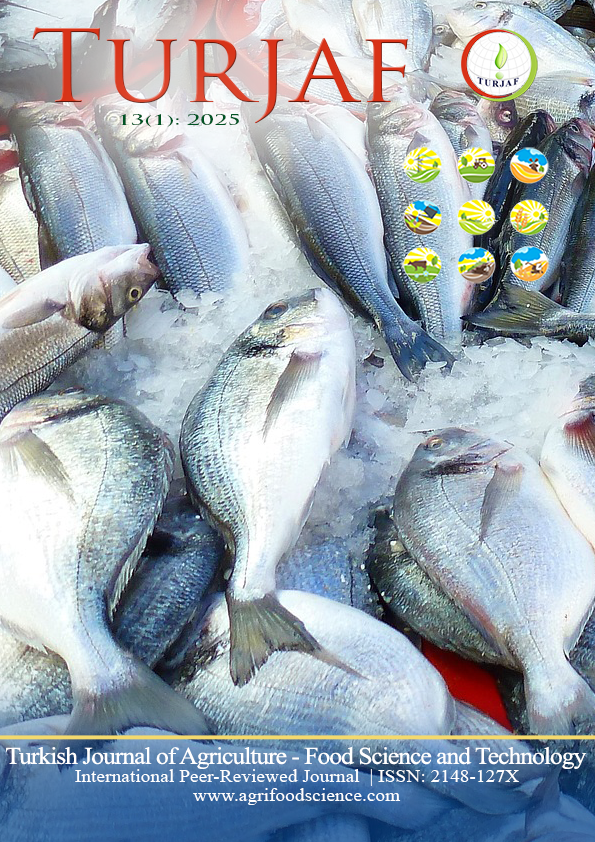Exploring the Antioxidant and Neuroprotective Potential of Muscari armeniacum: Phenolic Profiling and Enzyme Inhibition
DOI:
https://doi.org/10.24925/turjaf.v13i1.204-209.7355Anahtar Kelimeler:
Antioxidants- enzyme inhibitory- muscari armeniacum- phenolics- AcetylcholinesteraseÖzet
This study aimed to investigate the antioxidant and enzyme inhibitory properties of Muscari armeniacum, a plant native to Türkiye, which is known for its bioactive compound content. Ethanol extracts of Muscari armeniacum were prepared and analyzed using a variety of bioanalytical methods to assess its potential health-promoting properties. The antioxidant capacity was evaluated through Fe³⁺-Fe²⁺ reduction capacity, CUPRAC, DPPH, and ABTS radical scavenging activities. Additionally, the total phenolic and flavonoid contents of the extracts were determined, as these compounds are critical indicators of antioxidant potential. The antioxidant activity of Muscari armeniacum was compared with five standard antioxidants commonly used for benchmarking: BHA, α-tocopherol, BHT, trolox, and ascorbic acid. The extract demonstrated a high flavonoid content (23.24 µg QE/mg extract) and a significant amount of phenolics (14.38 µg GAE/mg extract), with the flavonoid content being particularly noteworthy. In addition to its antioxidant properties, the enzymatic activity assays revealed that the extract significantly inhibited acetylcholinesterase (AChE) and butyrylcholinesterase (BChE) enzymes, which are associated with neurodegenerative diseases such as Alzheimer’s. The IC₅₀ values were determined to be 54.14 mg/mL (R² = 0.9695) for AChE and 58.73 mg/mL (R² = 0.9609) for BChE, indicating moderate enzyme inhibition. These results suggest that Muscari armeniacum could serve as a valuable source of bioactive compounds with significant antioxidant and enzyme inhibitory activities. Its potential applications in the treatment of oxidative stress-related diseases and neurodegenerative disorders make it a promising candidate for further pharmacological studies. This research underscores the importance of exploring native plants for their medicinal and therapeutic potential, contributing to the development of alternative treatments for challenging health conditions.
Referanslar
Apak, R., Güçlü, K., Özyürek, M., Karademir Çelik, S., & Erçağ, E. (2006). The cupric ion reducing antioxidant capacity (CUPRAC) and polyphenolic content of some herbal teas. International Journal of Food Sciences and Nutrition, 57, 292-304. https://doi.org/10.1080/09637480600798132
Blois, M. S. (1958). Antioxidant Determinations by the Use of a Stable Free Radical. Nature, 181(4617), 1199-1200. https://doi.org/10.1038/1811199a0
Bokov, D. O. (2019). Muscari armeniacum leichtlin (grape hyacinth): phytochemistry and biological activities review. Asian Journal of Pharmaceutical and Clinical Research, 12(1), 68-72. https://doi.org/10.22159/ajpcr.2019.v12i1.30325
Durgun, M., Akocak, S., Lolak, N., Topal, F., Koçyiğit, Ü. M., Türkeş, C., Beydemir, Ş. (2024). Design and synthesis of pyrazole carboxamide derivatives as selective cholinesterase and carbonic anhydrase inhibitors: molecular docking and biological evaluation. Chemistry & Biodiversity, 21(2), e202301824.https://doi.org/https://doi.org/10.1002/cbdv.202301824
Ellman, G. L., Courtney, K. D., Andres, V., Jr. & Feather-Stone, R. M. (1961). A new and rapid colorimetric determination of acetylcholinesterase activity. Biochem Pharmacol, 7, 88-95. https://doi.org/10.1016/0006-2952(61)90145-9
Gulcin, İ. (2020). Antioxidants and antioxidant methods: an updated overview. Arch Toxicol, 94(3), 651-715. https://doi.org/10.1007/s00204-020-02689-3
İnan Ergün, A., & Topal, M. (2023). Determination of the antioxidant capacity of puerarin and its effect on cholinesterases by in vitro and in silico methods. ChemistrySelect, 8(41), e202302751. https://doi.org/https://doi.org/10.1002/slct.202302751
Kalın, P., Gülçin, I., & Gören, A. (2015). Antioxidant activity and polyphenol content of cranberries (Vaccinium macrocarpon). Records of Natural Products, 9, 496-502.
Lowell, B. B., & Shulman, G. I. (2005). Mitochondrial dysfunction and type 2 diabetes. Science, 307(5708), 384-387. https://doi.org/10.1126/science.1104343
Miyamoto, K., Kotake, T., Sasamoto, M., Saniewski, M., & Ueda, J. (2010). Gummosis in grape hyacinth (Muscari armeniacum) bulbs: hormonal regulation and chemical composition of gums. J Plant Res, 123(3), 363-370. https://doi.org/10.1007/s10265-009-0273-1
Muglu, H., Yakan, H., Erdogan, M., Topal, F., Topal, M., Turkes, C., & Beydemir, S. (2024). Novel asymmetric biscarbothioamides as Alzheimer's disease associated cholinesterase inhibitors: synthesis, biological activity, and molecular docking studies. NEW Journal of Chemistry, 48(24), 10979-10989. https://doi.org/10.1039/d4nj01462f
Oyaizu, M. (1986). Studies on products of browning reaction antioxidative activities of products of browning reaction prepared from glucosamine. The Japanese Journal of Nutrition and Dietetics, 44(6), 307-315. https://doi.org/10.5264/eiyogakuzashi.44.307
Özler, E., Topal, F., Topal, M., & Öztürk Sarıkaya, S. B. (2023). LC-HRMS Profiling and phenolic content, cholinesterase, and antioxidant activities of terminalia citrina. Chemistry & Biodiversity, 20(6), e202201250. https://doi.org/https://doi.org/10.1002/cbdv.202201250
Re, R., Pellegrini, N., Proteggente, A., Pannala, A., Yang, M., & Rice-Evans, C. (1999). Antioxidant activity applying an improved ABTS radical cation decolorization assay. Free Radical Biology and Medicine, 26(9), 1231-1237. https://doi.org/https://doi.org/10.1016/S0891-5849(98)00315-3
Sarikurkcu, C., Uren, M. C., Tepe, B., Cengiz, M., & Kocak, M. S. (2015). Phlomis armeniaca: Phenolic compounds, enzyme inhibitory and antioxidant activities. Industrial Crops and Products, 78, 95-101. https://doi.org/https://doi.org/10.1016/j.indcrop.2015.10.016
Topal, F., & Kocabaş, S. (2024). Determination of antioxidant capacities of extracts of sorbus subfusca (ledeb. ex. nordm.) boiss. Journal of the Institute of Science and Technology, 14(3), 1200-1208. https://doi.org/10.21597/jist.1456434
Topal, M. (2020). Secondary metabolites of ethanol extracts of pinus sylvestris cones from eastern anatolia and their antioxidant, cholinesterase and α-glucosidase activities. Records of Natural Products, 14, 129-138. https://doi.org/10.25135/rnp.155.19.06.1326
Topal, M., Ozturk Sarıkaya, S. B., & Topal, F. (2021). Determination of angelica archangelica’s antioxidant capacity and mineral content. ChemistrySelect, 6(31), 7976-7980. https://doi.org/https://doi.org/10.1002/slct.202102282
Topal, M., Topal, F., & Yılmaz, F. (2024). Exploring the impacts of Angelica purpurascens extracts on anticholinergic, antidiabetic, antibacterial potential, and antioxidant capacity. Journal of the Institute of Science and Technology, 14(2), 790-804. https://doi.org/10.21597/jist.1411501
Yoshida, K., Aoki, H., Kameda, K., & Kondo, T. (2002). Structure of muscarinin A, an acylated anthocyanin, from purplish blue spicate flower petals of Muscari arumeniacum. ITE Lett., 3, 35-38.
İndir
Yayınlanmış
Nasıl Atıf Yapılır
Sayı
Bölüm
Lisans
Bu çalışma Creative Commons Attribution-NonCommercial 4.0 International License ile lisanslanmıştır.

























